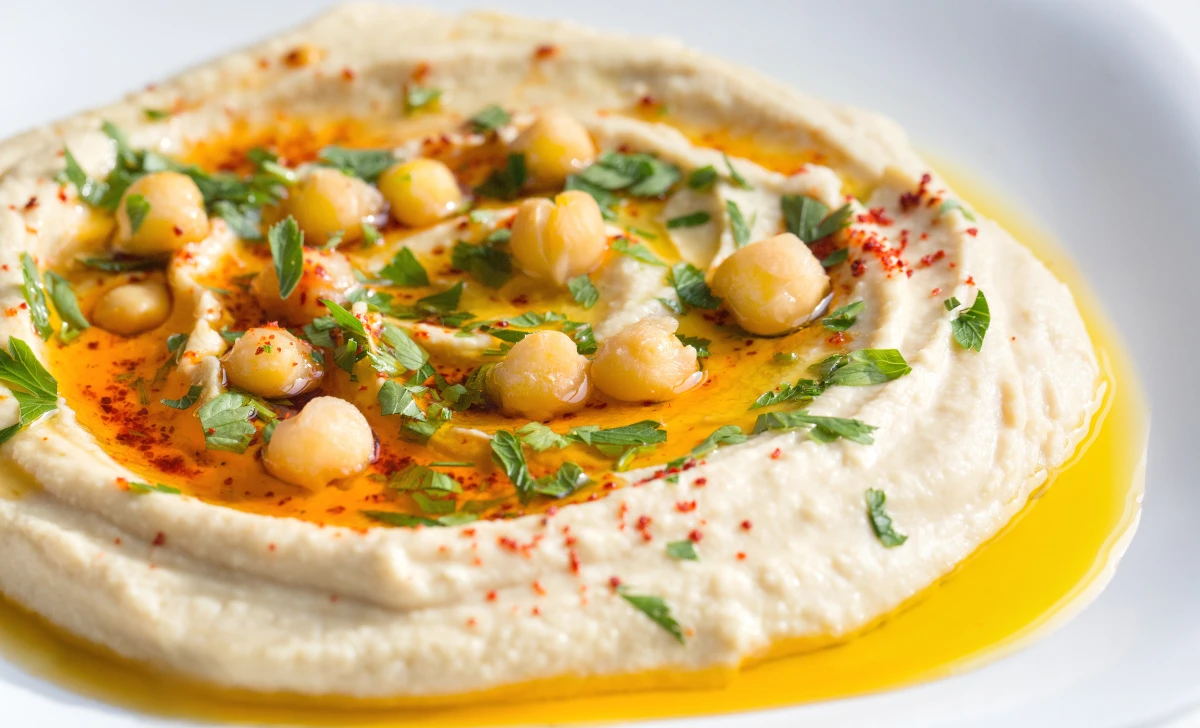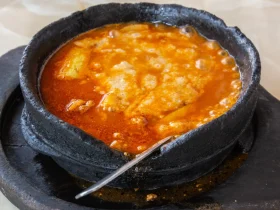Hummus, a staple in Middle Eastern cuisine, has gained popularity worldwide for its delicious taste and nutritional benefits. Made from simple ingredients like chickpeas, tahini, garlic, lemon juice, and olive oil, hummus offers a flavorful and creamy dip or spread that can be enjoyed with various dishes. In this article, we will explore the step-by-step process of making homemade hummus, its health benefits, and some exciting variations to try. So, grab your ingredients and let’s dive into the world of hummus!
[ez-toc]
History
The history of hummus can be traced back to ancient times, with its origins deeply rooted in the Middle East. While the exact historical origin is uncertain, hummus has been a beloved dish in the region for centuries.
The earliest records of hummus-like dishes date back to ancient Egypt, where a similar recipe using chickpeas and sesame seeds was found. This early version of hummus was known as “ṭaḥīna” and was enjoyed as a nutritious and versatile food.
Over time, the popularity of hummus spread across the Middle East, with various regions and cultures adding their unique twists to the recipe. Countries such as Lebanon, Israel, and Palestine have claimed hummus as part of their culinary heritage, each with their own variations and methods of preparation.
In Lebanese cuisine, hummus is often served as a mezze, a collection of small dishes served as appetizers or side dishes. Lebanese hummus typically includes ingredients like tahini, lemon juice, garlic, and olive oil. It is known for its creamy texture and delicate balance of flavors.
Throughout history, hummus has traveled beyond the Middle East, gaining popularity in countries around the world. It has become a favorite dip, spread, or filling in many cultures, thanks to its delightful taste and nutritional benefits.
In recent years, hummus has experienced a surge in popularity in the Western world. Health-conscious individuals appreciate hummus for its high protein and fiber content, as well as its heart-healthy fats. Its versatility allows it to be enjoyed as a dip, spread, or even a substitute for unhealthy condiments.
Today, hummus can be found in supermarkets, restaurants, and homes worldwide. Its rich history and cultural significance make it a symbol of the Middle Eastern culinary tradition. Whether enjoyed as a simple snack or incorporated into creative recipes, hummus continues to bring people together through its delicious flavors and shared heritage.
Time
| Step | Time |
|---|---|
| Cooking Chickpeas | 1 hour |
| Preparation Time | 10 minutes |
| Blending Ingredients | 5 minutes |
| Adjusting Consistency | 2 minutes |
| Total | 1 hour 17 minutes |
Please note that the cooking time for chickpeas may vary depending on whether you are using canned chickpeas or cooking them from scratch.
Ingredients
| Ingredients | Quantity |
|---|---|
| Cooked Chickpeas | 1 ½ cups |
| Tahini | ¼ cup |
| Freshly squeezed Lemon Juice | 3 tablespoons |
| Garlic cloves | 2 |
| Extra-virgin Olive Oil | 2 tablespoons |
| Ground Cumin | ½ teaspoon |
| Salt | To taste |
| Water | As needed |
Note: The ingredient quantities listed are for a serving size of 2 people. Adjust the quantities accordingly for more or fewer servings.
Directions
1. Cooking Chickpeas (if using dried chickpeas)
- Soak 1 cup of dried chickpeas in water overnight.
- Rinse the soaked chickpeas and transfer them to a large pot.
- Add enough water to cover the chickpeas and bring to a boil.
- Reduce the heat, cover, and simmer for about 1 hour or until the chickpeas are tender.
- Drain and set aside.
2. Preparation Time
- Gather all the necessary ingredients for making hummus.
- Have a food processor or blender ready for blending the ingredients.
3. Blending Ingredients
- In a food processor or blender, combine the cooked chickpeas (or canned chickpeas, rinsed and drained), tahini, freshly squeezed lemon juice, minced garlic cloves, extra-virgin olive oil, ground cumin, and a pinch of salt.
- Process the mixture until smooth and creamy.
4. Adjusting Consistency
- Check the consistency of the hummus. If it is too thick, gradually add water, a tablespoon at a time, while blending, until you achieve the desired texture.
- Taste the hummus and adjust the seasoning by adding more salt or lemon juice if needed.
5. Serving
- Transfer the hummus to a serving bowl.
- Drizzle a little olive oil over the top and sprinkle with a pinch of ground cumin for garnish.
- Optionally, you can also add some fresh herbs like parsley or a sprinkle of paprika for added flavor and visual appeal.
6. Enjoying
- Serve the homemade hummus with pita bread, fresh vegetables, or use it as a spread in sandwiches and wraps.
- Store any leftovers in an airtight container in the refrigerator.
Enjoy your delicious homemade hummus!
Equipment Required
Nutrition Information
| Nutrition Information | Amount per Serving |
|---|---|
| Serving Size | 1/4 cup (about 60g) |
| Calories | 145 |
| Total Fat | 10g |
| – Saturated Fat | 1.4g |
| – Trans Fat | 0g |
| Cholesterol | 0mg |
| Sodium | 90mg |
| Total Carbohydrate | 11g |
| – Dietary Fiber | 3g |
| – Sugars | 0.6g |
| Protein | 5g |
| Vitamin D | 0mcg |
| Calcium | 35mg |
| Iron | 1.5mg |
| Potassium | 150mg |
Please note that the nutrition information provided is an estimate and may vary depending on specific ingredients and serving sizes.
Tips
- For smoother and creamier hummus, remove the skins from the cooked chickpeas by rubbing them gently between your fingers before blending.
- Adjust the consistency of the hummus by adding water gradually until you achieve your preferred thickness. Remember, it will thicken slightly when refrigerated.
- To enhance the flavor, roast the garlic cloves before adding them to the mixture. This will impart a slightly nutty and mellow taste.
- If you prefer a stronger lemon flavor, add a bit more freshly squeezed lemon juice to the mixture. Start with small increments and adjust according to your taste preference.
- Allow the hummus to rest in the refrigerator for at least 30 minutes before serving. This will help the flavors meld together for a more pronounced taste.
Pros & Cons
| Pros | Cons |
|---|---|
| ✅ Healthy and Nutritious | ❌ Requires Preparation Time |
| ✅ High in Protein and Fiber | ❌ May Require Specialty Ingredients |
| ✅ Versatile and Customizable | ❌ Not Suitable for Those with Allergies to Chickpeas or Sesame |
| ✅ Suitable for Vegan and Vegetarian Diets | ❌ Texture and Flavor may not be Appealing to Everyone |
| ✅ Can be Made in Advance and Stored | ❌ May Need Adjustments to Achieve Desired Consistency |
Conclusion
In conclusion, hummus is a delightful and versatile Middle Eastern dish that offers a perfect blend of flavors and nutritional benefits. With its creamy texture and rich taste, it has become a beloved dip, spread, or accompaniment to various dishes worldwide. Making homemade hummus allows you to customize it to your liking, ensuring the freshest and most flavorful experience.
Not only is hummus incredibly delicious, but it also provides numerous health benefits. Packed with protein, fiber, and heart-healthy fats, hummus makes for a satisfying and nutritious addition to your meals or snacks. Its versatility allows you to explore different variations, from adding roasted red peppers for a smoky kick to incorporating fresh herbs for a burst of freshness.
Preparing hummus at home is a simple and rewarding experience. The step-by-step guide, along with the provided tips and tricks, ensures a successful outcome. Whether you enjoy it as a dip with fresh vegetables, a spread in sandwiches, or a flavorful addition to your mezze platter, hummus is sure to impress your taste buds and nourish your body.
So, why not embark on a culinary adventure and try making your own hummus today? Gather the ingredients, follow the recipe, and embrace the joy of creating a homemade masterpiece. Enjoy the satisfaction of savoring each creamy bite and indulge in the cultural heritage and flavors of the Middle East.
Remember, hummus is not just a recipe; it’s an invitation to explore new flavors, share delicious moments with loved ones, and celebrate the joys of cooking and good food. Don’t miss out on this delightful experience – get ready to embark on a hummus adventure that will leave you craving more.
Facts
- Fact 1: 🌍 Hummus, a World Record Breaker!
- Hummus holds the Guinness World Record for the largest dish of hummus ever made. In 2010, Lebanon set the record with a colossal hummus dish weighing over 23,000 pounds!
- Fact 2: 🥇 The Oldest Recipe in the World
- The earliest known recipe for a hummus-like dish can be traced back to ancient Mesopotamia, around 1750 BCE. It was discovered on a cuneiform tablet, making it one of the oldest recorded recipes in the world!
- Fact 3: 🚀 Hummus in Space
- In 2015, the International Space Station (ISS) received its first-ever hummus delivery. This made hummus the first Middle Eastern dip to reach outer space, giving astronauts a taste of Earth’s culinary diversity.
- Fact 4: 🎉 National Hummus Day
- Hummus has its own holiday! National Hummus Day is celebrated on May 13th each year, bringing hummus lovers together to enjoy this delectable dish and celebrate its cultural significance.
- Fact 5: 🌱 Hummus: A Green Alternative
- Did you know that hummus has an eco-friendly side? The production of hummus requires fewer resources and generates fewer greenhouse gas emissions compared to many other spreads or dips. So, enjoy your hummus guilt-free!
FAQ’s
Can I use canned chickpeas instead of cooking them from scratch?
Yes, using canned chickpeas is a convenient alternative. Ensure you rinse and drain them thoroughly before using.
How long does homemade hummus last in the refrigerator?
Homemade hummus can last up to one week when stored properly in the refrigerator.
Is hummus suitable for a vegan diet?
Yes, hummus is a vegan-friendly option as it is free from animal products.
Can I substitute tahini with another ingredient?
While tahini adds a distinct flavor to hummus, you can substitute it with natural nut butter or sunflower seed butter if needed.
How can I adjust the consistency of hummus?
If the hummus is too thick, you can add water, a tablespoon at a time, while blending until you achieve the desired consistency.
Can I freeze hummus?
Yes, you can freeze hummus for up to three months. Thaw it in the refrigerator before serving and give it a good stir.
Can I add other spices or herbs to customize the flavor of hummus?
Absolutely! You can experiment with various spices and herbs like paprika, cayenne pepper, cumin, fresh basil, or parsley to add your desired flavors to the hummus.
Is hummus gluten-free?
Yes, hummus is naturally gluten-free as it is primarily made from chickpeas, tahini, and other gluten-free ingredients. However, always check the labels of store-bought ingredients to ensure they are gluten-free.
How can I make hummus less garlicky?
If you prefer a milder garlic flavor, you can reduce the number of garlic cloves or roast them before adding them to the hummus to mellow out their taste.
Can I adjust the amount of lemon juice in the recipe?
Yes, you can adjust the amount of lemon juice to suit your taste preferences. Start with the suggested amount and add more if you prefer a stronger lemon flavor or less if you prefer a milder taste.












Leave a Review